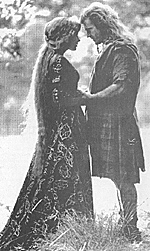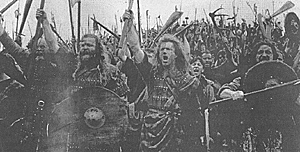 One of the central themes in
Braveheart is the willingness of its
characters to sacri. fice themselves for higher
ideals. The Scottish revolutionaries in
general, and Wallace in particular, have all
made tremendous sacrifices in the pursuit of
a free country, and are willing to die for it.
Wallace's unbending, passionate commitment
to the cause pervades every facet of his
being, and he cannot be deterred by anything.
One of the central themes in
Braveheart is the willingness of its
characters to sacri. fice themselves for higher
ideals. The Scottish revolutionaries in
general, and Wallace in particular, have all
made tremendous sacrifices in the pursuit of
a free country, and are willing to die for it.
Wallace's unbending, passionate commitment
to the cause pervades every facet of his
being, and he cannot be deterred by anything.
If the players are to play Wallace or be a part of Wallace's cause, they should exercise a similar passion. The film's noblemen were portrayed as villainous mercenaries whom Edward bought off with land and titles. Most players are used to receiving monetary rewards and may exercise similar greed when confronted with the situation. This will not work, and characters evincing such traits should be saved for another campaign. Wallace cannot offer them riches or nobility or rewards. What he can offer them is the possibility of freedom, of independence from tyranny and the machinations of evil men. The players need to understand and accept that before they become involved in his fight.
The sort of passion Wallace exercised forms the crux of a second theme, possibly the most important of the story. Braveheart embodies the dichotomy between the huge epic of a full-out war and the personal stories at the middle of it. The two acheive a symbiosis that is vital to maintaining the atmosphere of the film.
Other movies show small people caught up in huge conflicts, but rarely are those conflicts so deeply rooted in the stories of those small people. Wallace joined the rebellion to avenge the death of his wife; his leadership is characterized by friendships with Hamish and Stephen, and the camaraderie their shared struggle brings. The enemies they face on the battlefield are individual men with unique quirks and attributes. Even the great nobles and kings are portrayed in personal detail, and the machinations which decided the fate of the nation had some very human faces behind them.
At the same time, this doesn't detract from the sheer size of the production. The battles and conflicts were filmed on an epic scale with a cast of over two thousand, emphasizing the chaos and spectacle that such battles embodied. The wide-open spaces of Scotland and Ireland are illustrated in larger-than-life grandeur, as civilization has only just begun to make its imprint upon the land. And the film's three hour length presents a story that can, not fit into an concise summary, stretching over the founding history of an entire country.
In the middle of all this lies the central characters, whose personal interactions causes ripples that expand far beyond the scope of the individual. The balance between small and large is vital to establishing the feeling of Braveheart.
Fortunately, in a fantasy RPG setting, this is very easy. If the players are using their own characters, they should know Wallace personally. They should fight alongside Hamish and Campbell, and should recognize the faces of their enemies. At the same time, they should understand the ramifications of their fight, and the effects it may have beyond their own personal lives.
The battles they participate in should be described from their perspective, but should contain far more combatants than they can see. Miniatures and descriptions of large scale movements will destroy this feeling; keep it personal, but make it clear that thousands are taking part in the same conflict. When the battle is won or lost, or if some political development has occurred, make sure the players see the ramifications of it - physical, cultural and political - in the homes and villages they pass through. This can be done very quickly with a little care and attention to detail, and experienced GMs may be surprised at how well their own methods embody this theme.
Bringing Braveheart Into Your Campaign
Players and GMs may want to stick purely with the film and with historical fact in designing a Braveheart campaign: playing Wallace or Robert the Bruce, skirmishing with English troops, etc. Such a campaign can be brought off with little more than a viewing of the movie and some research on the period at the local library.
Others, however, may want to adapt the characters and settings into their own world, which causes a few more problems. Most fantasy campaigns are set in fictitious universes, and "Braveheart's" uniquely Scottish struggle may seem out of place therein. But with a little adjustment, the events and characters can be made to fit just- about any campaign.
Braveheart takes place in the High Middle Ages, which is the same period as most fantasy RPG's. Technology and battle tactics are roughly the same, and the feudal system of government is practically identical. Tyrannical kings are hardly new, and all the characters need is some reason to fight against him. If that can be established, then Wallace and his compatriots are the natural choices for the leaders of the revolt.
The biggest difficulty is the sense of national character which pervades every facet of Braveheart. William Wallace is a Scotsman tried and true, and picturing him without a kilt or a thick brogue destroys the character beyond repair. A campaign with him in it needs to include at least the trappings of Scotland in order to achieve the right atmosphere.
GMs should keep this in mind when setting up their scenario, and give Wallace's nation - however fictitious it may be - the feeling of Edinburgh and the Highlands. No, this doesn't mean they have to play bagpipes and have clan tartans, but enough flavor should be there to give the players a healthy impression of the Northern British Isles.
The setting should be hilly and rainy, with low clouds hugging the mountain peaks. The characters should dress in earthy tones, and the men should wear kilts if possible. If you can effect a Scottish accent, that can go a long way towards establishing character. A few touches along those lines should be more than enough to convey the proper impression.
Hook, Line and Sinkers
 The following adventure outlines are designed for characters other than Wallace
and his men.
The following adventure outlines are designed for characters other than Wallace
and his men.
To the Aid of a Noble
Hook: The characters are at an inn or any suitable convenient location. They are approached by a page who states that "a gentleman of some renown" wishes to speak to them. There is a carriage outside waiting to transport them to a more private location.
Line: Arriving at a fortified castle, the characters are greeted by Robert the Bruce. Ushering them in, he explains that he wishes to use the characters to covertly aid Wallace, since he himself cannot. He has supplies and information he wishes them to send to him, and will provide them with any equipment they need.
Sinker: Robert's father, however, has gotten wind of the deal and takes steps to stop it. He informs Edward of the characters' location, and has the local magistrate dispatch a squad of assassins to stop them. The Englishmen may let the characters live if they turn over the supplies and information. Do they fight it out? Switch sides? Or let the troops take their supplies? If they do, they can still fulfill their mission by finding Wallace and giving him the information in person...
This scenario can also be run with Princess Isabelle as the noble in need of aid.
Prima Nocte
Hook: The characters are enjoying the wedding of a close friend in the local village. In the midst of the festivities, an English lord rides up with a company of men in tow. He has come to claim the right of Prima Nocte and plans to bed the bride this very night.
Line: The groom is incensed and wishes to fight, but the odds are stacked against them and the lord absconds with the bride. The groom wishes the characters to help him rescue his love before she can be ravished.
Sinker: If the characters agree, they must break into the local castle, locate the kidnapped bride and make their escape. Once they have done so, however, they will be wanted criminals, hunted for violating the nobleman's sacred rights. They must flee into the hills and perhaps join up with Wallace and his men if they wish to avoid arrest...
Further Research
The books listed below provide fairly solid information on Wallace and the time in which he lived:
Barron, E.M. The Scottish War of Independence.
Barrow, G.W.S. Robert Bruce and the Community of the Realm of Scotland
Fergussen, James. William Wallace, Guardian of Scotland.
Fisher, Andrew. William Wallace.
Nicholson, Ranald. Scotland: the Later Middle Ages.
Prestwich, Michael. Three Edwards: War and State in England, 1272-1377.
Tout, T.F. Edward the First.
And, of course, the film itself is absolutely required viewing.
In the year of our Lord 1314, patriots of Scotland, starving and outnumbered, charged the fields of Bannockburn. They fought like warrior poets. They fought like Scotsmen. And won their freedom. Forever.
More Angry Men In Kilts Braveheart
-
Introduction and History
Themes and Ideas of Braveheart
Character: William Wallace
Character: King Edward I (Longshanks)
Character: Princess Isabelle
Character: Murron
Character: Robert The Bruce
Character: Prince Edward
Character: Hamish
Character: Stephen
Character: Campbell
Back to Shadis #20 Table of Contents
Back to Shadis List of Issues
Back to MagWeb Master List of Magazines
© Copyright 1995 by Alderac Entertainment Group
This article appears in MagWeb (Magazine Web) on the Internet World Wide Web.
Other military history articles and gaming articles are available at http://www.magweb.com